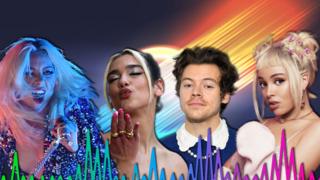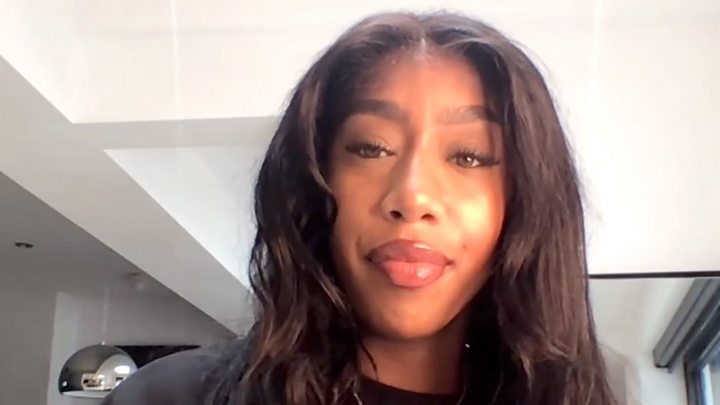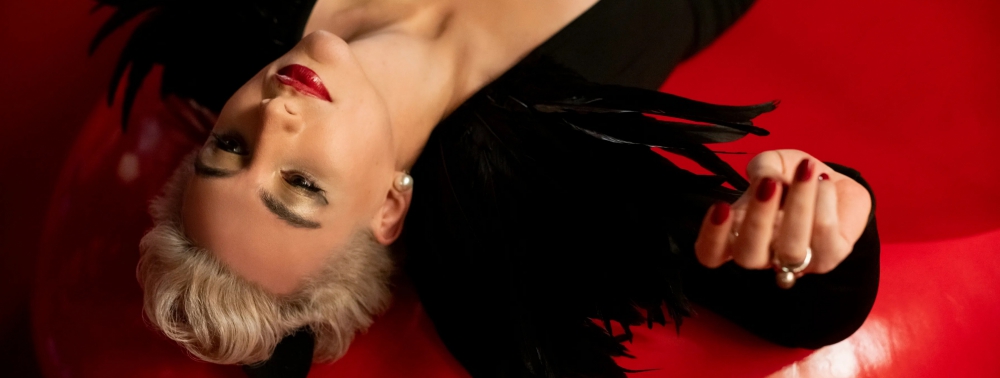
Getty Images / BBC
Hits by Lady Gaga, Dua Lipa, Harry Styles and Doja Cat are bucking the trend for slower, melancholy songs
“This is my dancefloor, I fought for,” Lady Gaga sings euphorically on Free Woman, a track from her new album, Chromatica.
She’s not alone. The charts are suddenly crammed with pop songs that celebrate joy and sensuality and precipitous thrill: Dua Lipa’s Physical, Doja Cat’s Say So, Harry Styles’ Watermelon Sugar and Gaga’s own Stupid Love.
At the same time, music is getting faster.
The average tempo of 2020’s top 20 best-selling songs is a pulse-quickening 122 beats per minute. That’s the highest it’s been since 2009.
Average tempo of a hit song
Based on the Top 20 best-sellers each year
The outbreak of euphoria is as sudden as it is unexpected.
For the last few years, pop has been getting slower, as artists like Ariana Grande and Billie Eilish incorporate the leisurely cadences and rhythms of southern hip-hop and trap music into their songs.
Lyrics have taken a darker turn, too, with expressions of loneliness, fear and anxiety becoming increasingly common.
In 2017, a Californian mathematician called Natalia Komarova was so shocked by the negativity of the songs her daughter listened to, she decided to investigate.
The rise of the ‘sad banger’
Using the research database AcousticBrainz – which allows you to examine musical properties like tempo, key and mood – she and her colleagues at the University of California Irvine examined half a million songs released in the UK between 1985 and 2015.
They found a significant downturn in the positivity of pop songs. Where 1985 saw upbeat tracks like Wham’s Freedom, 2015 favoured more sombre music by Sam Smith and Adele.
“‘Happiness’ is going down, ‘brightness’ is going down, ‘sadness’ is going up,” said Komarova of her results, “and at the same time, the songs are becoming more ‘danceable’ and more ‘party-like’.”
“So it looks like, while the overall mood is becoming less happy, people seem to want to forget it all and dance.”
In other words, Komorvoa had identified the rise of the “sad banger”, a song whose instrumental sets you up for good times, only to sucker punch your heart with lyrics of Biblical sadness.
For that, we can thank Swedish pop star Robyn, whose hit single Dancing On My Own influenced a generation of songwriters.
Released in 2010, it documented the brutal moment you see your ex kissing their new partner on a night out, and your world falls apart while everyone around you is having fun.
Lorde called it “perfect”, Christine & The Queens said she could “only marvel” at the song’s emotional impact, Sam Smith observed that it made Robyn “a huge part of the LGBTQ community because we get to dance our pain away”.
Turning heartbreak into a fist-pumping emotion was Robyn’s masterstroke – and as the 2010s progressed, her fingerprints were all over hits like Rihanna’s We Found Love, Taylor Swift’s Out Of The Woods and Dua Lipa’s New Rules.
At the same time, however, pop was decelerating.
By 2017, the average tempo of a hit single in the UK was 104 beats per minute, down from a high of 124bpm in 2009. In the US, where hip-hop is more prevalent on the charts, it fell as low as 90.5 bpm.
“People were burnt out on uptempo, super poppy stuff like they were with hair-metal bands back in the day,” songwriter Bonnie McKee told Rolling Stone magazine in 2017.
“Then as the sociopolitical climate got darker, people just weren’t in the mood to hear some upbeat bop.”
Just three years later, the trend is in reverse.
Permission to feel joy
“I’m looking at the top 20 now and, if you were to play the chart in order, you wouldn’t think the world is going through a crisis,” says pop star Raye, who has written for the likes of Beyonce, Little Mix and Stormzy alongside her solo hits.
“You would expect political or emotional music matching the aura of the time to be more prevalent, but it’s actually the opposite – which shows how we’re coping in the UK especially.
“Tempo, pace, escapism: Music that draws you out of the reality of what is going on right now; and transports you to somewhere more positive and uplifting.”

Media playback is unsupported on your device
Music journalist Charlie Harding, who hosts the Switched On Pop podcast, agrees there’s been “an important psychological change” in people’s listening habits.
“During moments of great distress, music provides hope. A pop song gives us permission to access joy, even when the world is burning.
“But music is more than just escapism. It can help us imagine a different way of life. Protest anthems motivate us to keep marching in the streets even when our feet are tired. Dance songs help us blow off steam at home, especially when we can’t go dancing out on the town.
“This upbeat shift happened during the great depression and during World War Two. Once again we need sounds that help us forge a path to the world we want to live in, not the one we’re inhabiting today.”
That last point is important, because the new wave of upbeat pop wasn’t written specifically for the bizarre circumstances of 2020 – it just happened to be ready at the right time.
Dua Lipa’s escapist pop opus Future Nostalgia was finished late last year, while Lady Gaga’s decided to make Chromatica a “fun” and “energetically pure” dance album back in 2017.
It followed a period where the star eschewed pure pop to try on new guises – jazz chanteuse, country crooner and Oscar-baiting balladeer. In that period, the average tempo of her singles dropped below 100bpm.
But Chromatica isn’t pure escapism. It’s possibly Gaga’s most personal record to date, discussing topics like her sexual assault, the antipsychotic medication she’s been prescribed, and the fibromyalgia which leaves her in chronic pain.
If you run the lyrics through linguistical analysis software, you’ll find that positive emotional words only slightly outweigh the negative ones (accounting for 3.36% vs 3.12% of the overall total word count).
Combined with the album’s accelerated beats, the lyrical tension ultimately creates a feeling of rejoice and release – as Gaga puts her problems behind her and struts onto the dancefloor.
‘Shut off and dance’
“We knew that Stupid Love felt good, and the other songs we were writing gave gloomy, hard, tearful days bright endings,” said music producer BloodPop, who worked on 12 of the record’s 16 tracks.
“You could physically see dance music healing this person in real time so it just became obvious very quickly that that’s what we had to do,” he told Rolling Stone.
Dua Lipa’s record was cathartic in a different way – written to “get away from pressures and anxieties and opinions from the outside world,” as she tried to follow-up her hugely successful debut.
Releasing it during the pandemic gave the music an added sense of urgency.
“I wanted to give people some happiness during this time, where they don’t have to think about what’s going on and just shut off and dance,” she said.
Dua and Gaga aren’t the only stars putting ecstasy back into the equation – and Spotify can (sort of) prove it.
The service helpfully collects metadata on the 50 million songs in its database, rating them for things like “danceability”, “energy” and “acoustic-ness”. But the measure we’re interested in is called valence – and it rates a song’s positivity.
Tracks with high valence sound more positive (happy, euphoric), while tracks with low valence sound more negative (sad, angry). It’s not a perfect measure. Pharrell’s Happy gets a score of 96%, as you might expect, but so does Aloe Blacc’s I Need A Dollar – a story of unemployment and poverty.
You could argue it’s really measuring jauntiness – but that’s still a reasonable indicator of music’s prevailing mood.
We looked at the valence for the UK’s top 20 best-selling singles every year of the last decade. As you would expect, the score tends to hover around the half-way point.
The decade’s happiest year was 2017, as listeners sought refuge from political turmoil in songs like Ed Sheeran’s Shape Of You and Luis Fonsi’s Despacito, dragging the average valence up to 62%.
After a couple of years decline, poptimism is back. The 20 best-selling songs so far this year score 57% on the happiness scale.
Average happiness of a hit song
Based on the Top 20 best-sellers each year
If you zoom in on individual artists, the pattern becomes even more pronounced.
Lady Gaga, Ed Sheeran, Dua Lipa and Taylor Swift are all on an upwards curve after releasing albums that were introspective or downbeat or fuelled by revenge in the mid-2010s.
Even Drake, an artist so perennially miserable that there are 84 separate playlists called “Sad Drake Songs” on Spotify, has become more optimistic.
His latest hit, Toosie Slide, has a valence of 84%, making it the “happiest” of the 58 singles he’s released so far.
Notably, the song was written specifically to go viral on TikTok, the video sharing app that’s become an increasingly important way for artists to share their new music.
Eight of the top 20 best-selling singles in the UK this year were boosted by their presence on the platform – and those songs tend to have a higher valence, scoring an average of 69% positivity, compared to 49% for the remaining 12 tracks.
How happy are our pop stars?
Whatever prompted the shift, pop star Charli XCX is in favour of it.
“I feel like everything was so hip-hop infused for so long that maybe it’s fun for it to be about it being so sugary and pop and happy,” she told Billboard’s Pop Shop podcast.
“That Doja Cat song makes me feel so happy. And same with the Dua song – it feels like I’m in a rom-com. I think that’s really joyous and cool because I feel like there was a lot of darkness in pop for a long time.”
Where pop’s biggest names go, imitators will inevitably follow. But Raye says writing rose-tinted pop hits during the lockdown has been a challenging experience.
“It’s a real battle between do I address how I feel and what’s going on, or do I just create something that feels the opposite?” she says. “But I think if we were to be sitting on Zoom writing ballads, we’d just feel depressed, so it kind of makes sense to channel this upbeat 80s vibe.”
Image copyright
Getty Images
Raye’s hits include You Don’t Know Me and Secrets
Meanwhile, Becky Hill, whose top 10 hits include Wish You Well and Gecko (Overdrive), says aspiring writers should be cautious about trying to capitalise on the happy pop revival.
“I try not to compare myself or my music to anyone else because music takes so friggin’ long to get released,” she says.
“So if you’re writing for a trend, you’ve got to look at that song to not be coming out for the next, at least, eight weeks. And by that point everyone’s probably moved on to something else.”
But singer-songwriter Kamille, the Brit Award-winner behind Little Mix’s Shout Out To My Ex and Mabel’s Don’t Call Me Up says that, when she writes upbeat songs, she’s mostly writing for herself.
“Music is a haven and an escape,” she says. “When I’m on streaming services, I’m listening to something that’s going to make me feel good and give me energy, because I’ve got so little of it at the moment.”
She says that cueing up a track like A-Ha’s Take On Me can alter the course of her day.
“Immediately, my mood changes and I feel excited and my heart starts to race. It’s like a little natural high.”
Follow us on Facebook, or on Twitter @BBCNewsEnts. If you have a story suggestion email [email protected].




